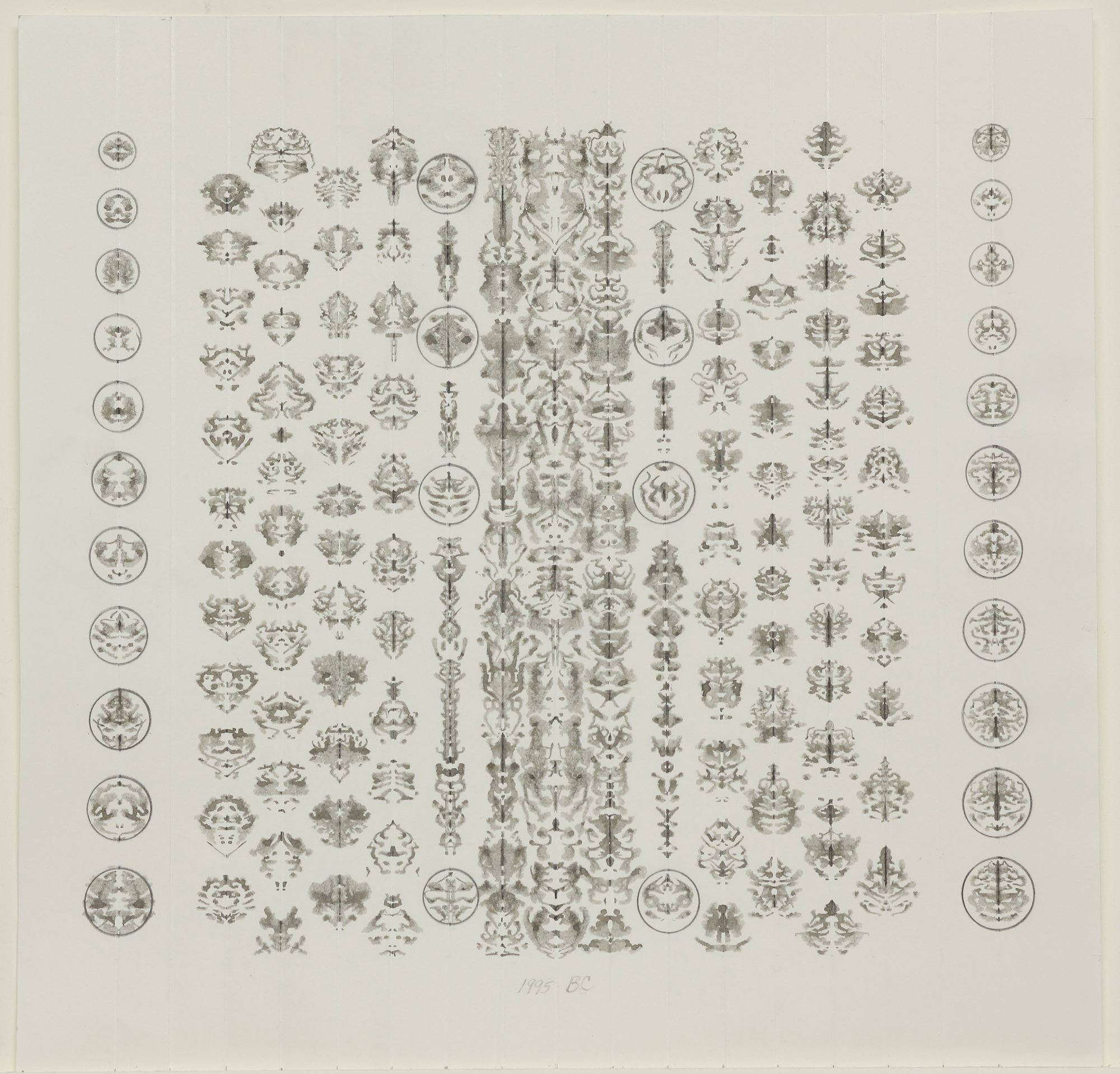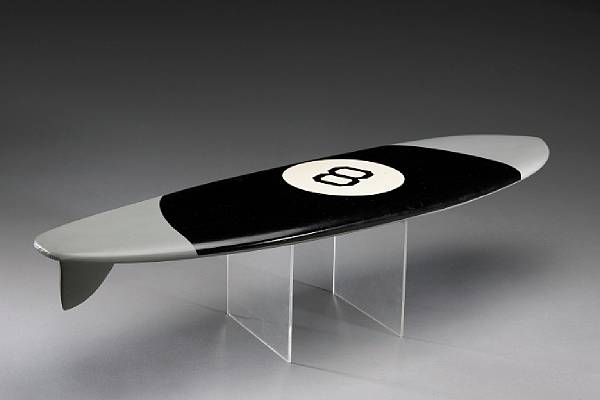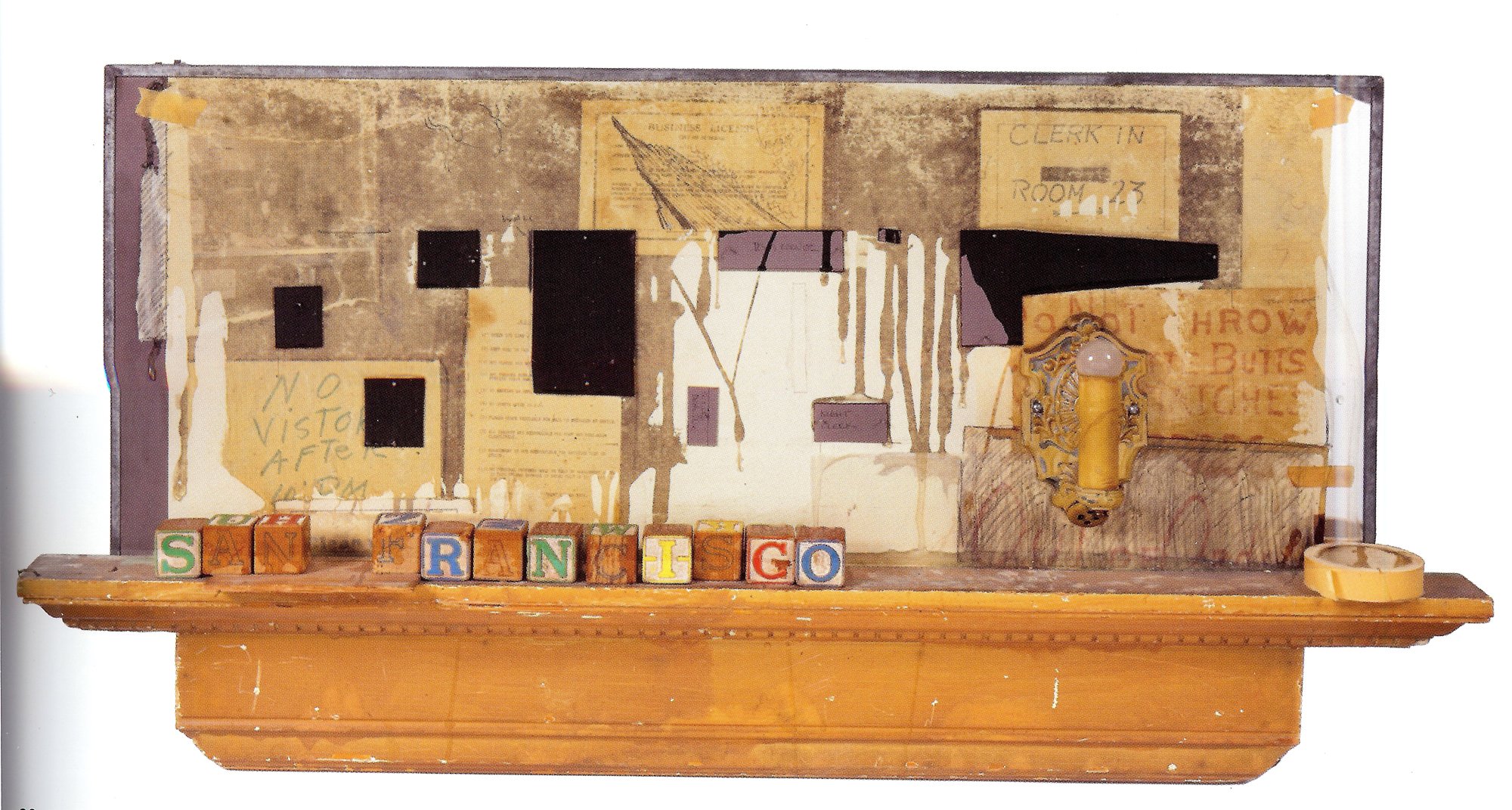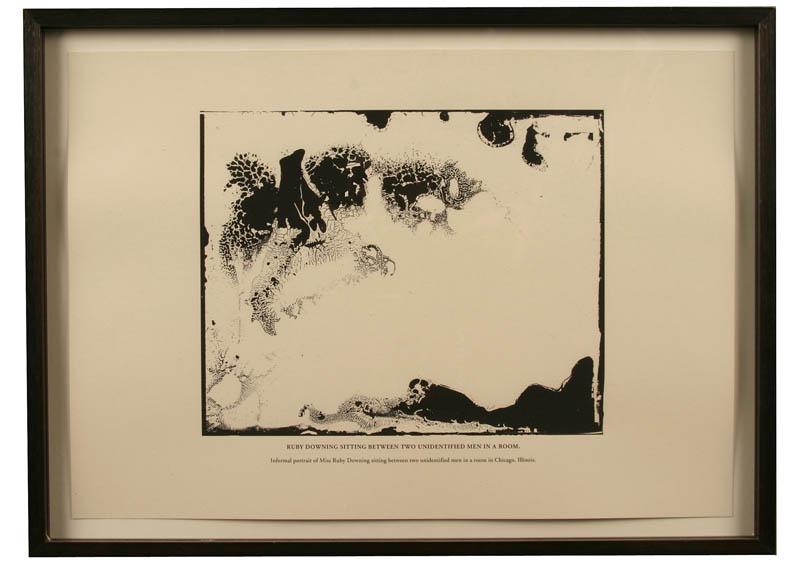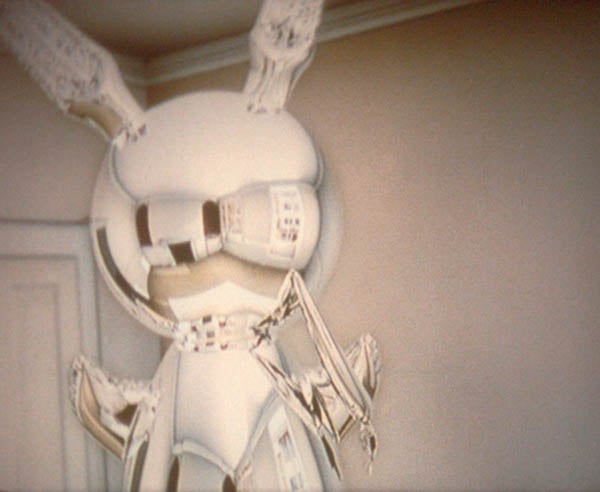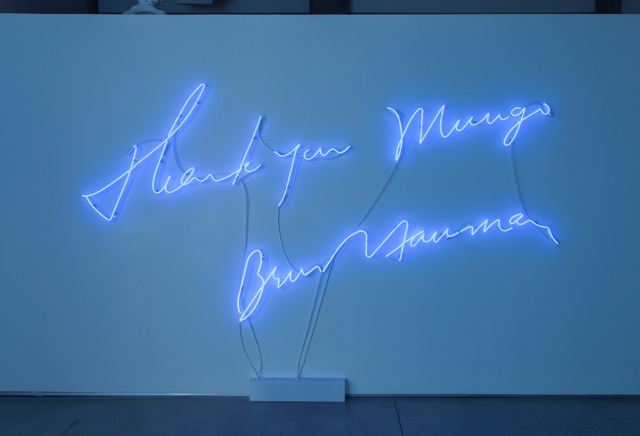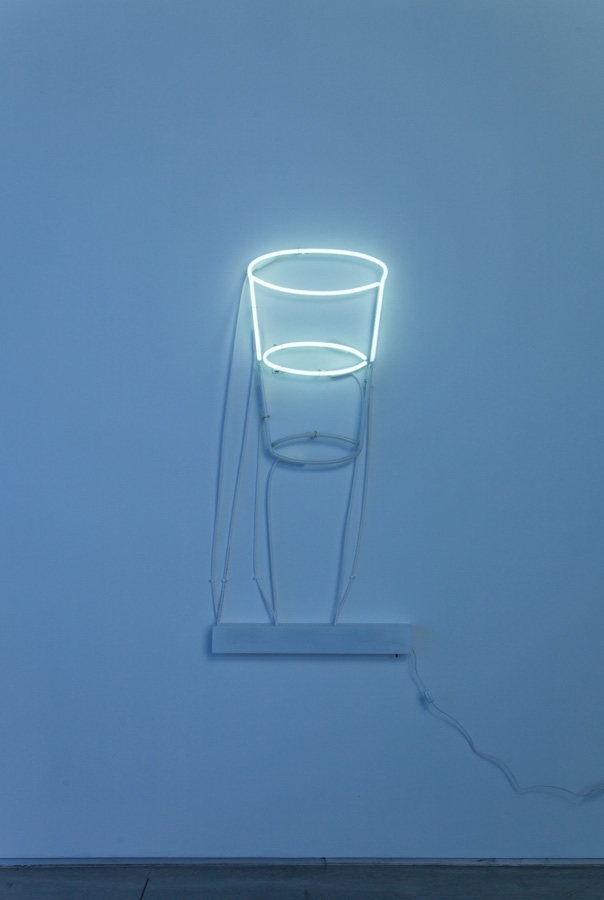
© » KADIST
Jin Shan
Retired Pillar represents the death and deterioration of legacy of colonial Shanghai. The silicon Corinthian column lays horizontal upon its pedestal, inflating and deflating in the rhythm of difficult breathing, as if exhausted by its lifelong labor. Shan comments on the deterioration of the influence of French colonialism within Shanghai as well as the adoption of Western forms of architectural decoration as symbols of wealth and power.

© » KADIST
Juan Capistran
The Breaks reflects Capistran’s interests in sampling and fusing different cultural, social, and historical sources. Growing up in an African-American community in Los Angeles, Capistran has long been influenced by hip-hop culture. The photographs in this print document him surreptitiously breakdancing on Carl Andre’s iconic lead floor piece after the guards at the Los Angeles County Museum of Art have left the gallery.

© » KADIST
Kelley Walker
The triptych Black Star Press is part of the series ‘The Black Star Press project’ initiated in 2004 by the American artist Kelley Walker. The images in this series are taken from a photo essay on the struggle for civil rights in Alabama, directed by Charles Moore in 1962 (and published by the magazine ‘Life’) which showed the repression of the black population and persistent inequalities in the southern United States. The title “Black Star Press” is taken from the name of the news agency where Charles Moore worked, and it refers to the young black man shot fighting for the rights of his community.

© » KADIST
Gabriel Sierra
Untitled consists of a small wooden sculpture that leans against a wall. Here, a rectangular piece of wood holds a folded article from a vintage design magazine whose Italian text states: “Villa per una persona sola. Arquitectura Pasadena California.” On the flipside of the paper is a feature with different images of paintings and architecture, including a painting by Piet Mondrian.

© » KADIST
Charles Gaines
To make his series Shadows (1980), Gaines subjected 20 potted plants to a uniform procedure. Each is pictured four times: a photograph of the plant, a photograph of its shadow, a drawing of the plant, and a drawing of its shadow. Instead of lending structure to disparate entities, this system serves a counterintuitive purpose, dissolving the object.

© » KADIST
Luke Butler
Drawing & Print (Drawing & Print)
In Captain X , Star Trek’s Captain Kirk, played by William Shatner, is limply draped over a large boulder in what looks like a hostile alien environment. However, Kirk’s passive pose doesn’t so much suggest the aftermath of a battle as it does heavy contemplation, depression, or utter despair. Captain X is part of a series of paintings depicting various Star Trek characters who are stricken with human emotion-—a tactic that diminishes the mythological grandeur associated with this heroic captain and his indefatigable crew.

© » KADIST
Matt Lipps
Untitled (Women) (2011) presents a startlingly succinct history of violently romanticized femininity. Matt Lipps created this diptych by photographing a single arrangement of cutouts. As in his analogous portrait of men, the middle section appears twice, on either side of the split, signaling a stutter, a caesura, or a schizophrenic break.

© » KADIST
Jonathan Monk
Drawing & Print (Drawing & Print)
Meeting #100 is one in a series of text works by Jonathan Monk. In this series, the artist attempts to organize meetings somewhere in the world. The audience is given the details of a meeting—the place, date and time—and nothing more.

© » KADIST
Jonathan Hernández
In line with Hernández’s interest in catastrophe, Vulnerabilia (choques) is a collection of images of shipwrecks and Vulnerabilia (naufragios) collects scenes of car crashes. The artist has said that the appropriation of popular imagery is a way for him to take pictures without a camera and to register the things that happen in the everyday as visual essays that evidence the fragility of the world.

© » KADIST
Daniel Joseph Martinez
Martinez’s sculpture A meditation on the possibility… of romantic love or where you goin’ with that gun in your hand , Bobby Seale and Huey Newton discuss the relationship between expressionism and social reality in Hitler’s painting depicts the legendary Black Panther leaders Huey P. Newton and Bobby Seale. By using Carrara marble, a material usually associated with heroic public sculptures, Martinez casts the history of African-American revolutionaries into the artistic tradition of monumentality. Like the artist’s earlier work included in the 1993 Whitney Biennial, an interactive piece made up with pins that read, “I CAN’T IMAGINE EVER WANTING TO BE WHITE,” A meditation on the possibility… continues Martinez’s effort to expose cultural contradictions and increase public awareness.

© » KADIST
Kota Ezawa
The Crime of Art is an animation by Kota Ezawa that appropriates scenes from various popular Hollywood films featuring the theft of artworks: a Monet painting in The Thomas Crown Affair (1999), a Rembrandt in Entrapment (1999), a Cellini in How to Steal a Million (1966), and an emerald encrusted dagger in Topkapi (1964). Ezawa uses his signature cartoon-like style to remix and reenact these crime scenes, leaving only the artworks as “real” objects (as they are depicted in the films), rather than illustrating them. Reversing fiction and reality in an unexpected way, this gesture invites the viewer to question the reliability of the visual footage.
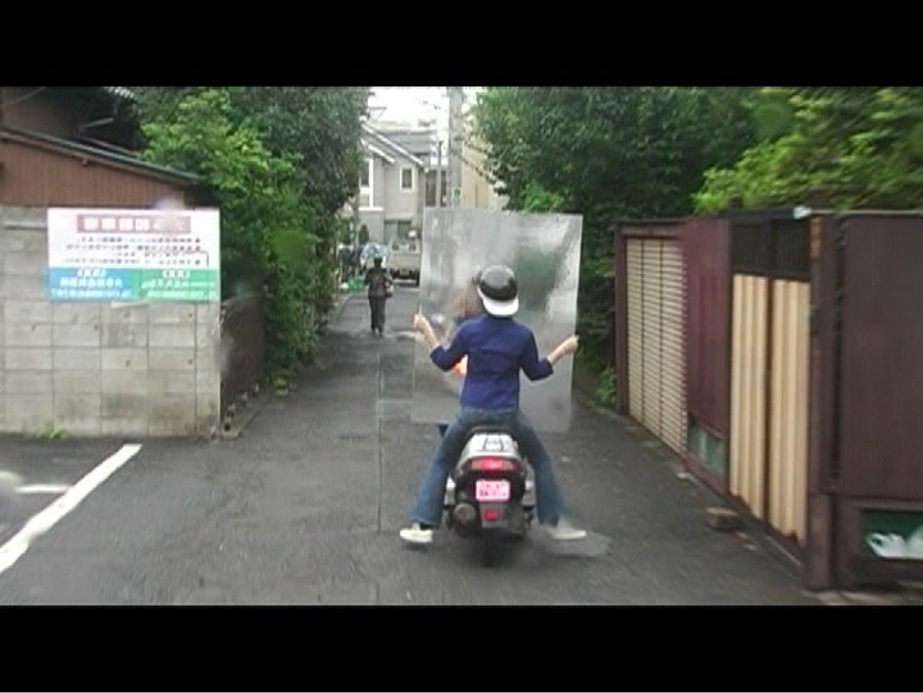
© » KADIST
Will Rogan
Shot in the streets of Tokyo, Collapse , is a meditation on the passing of time and on the complicated way in which we are smashed between the past and the future. The video follows a moped carrying a woman holding a very large mirror. The mirror is large enough that she can’t see what lies ahead, she can only see what has already come as reflections in the mirror.
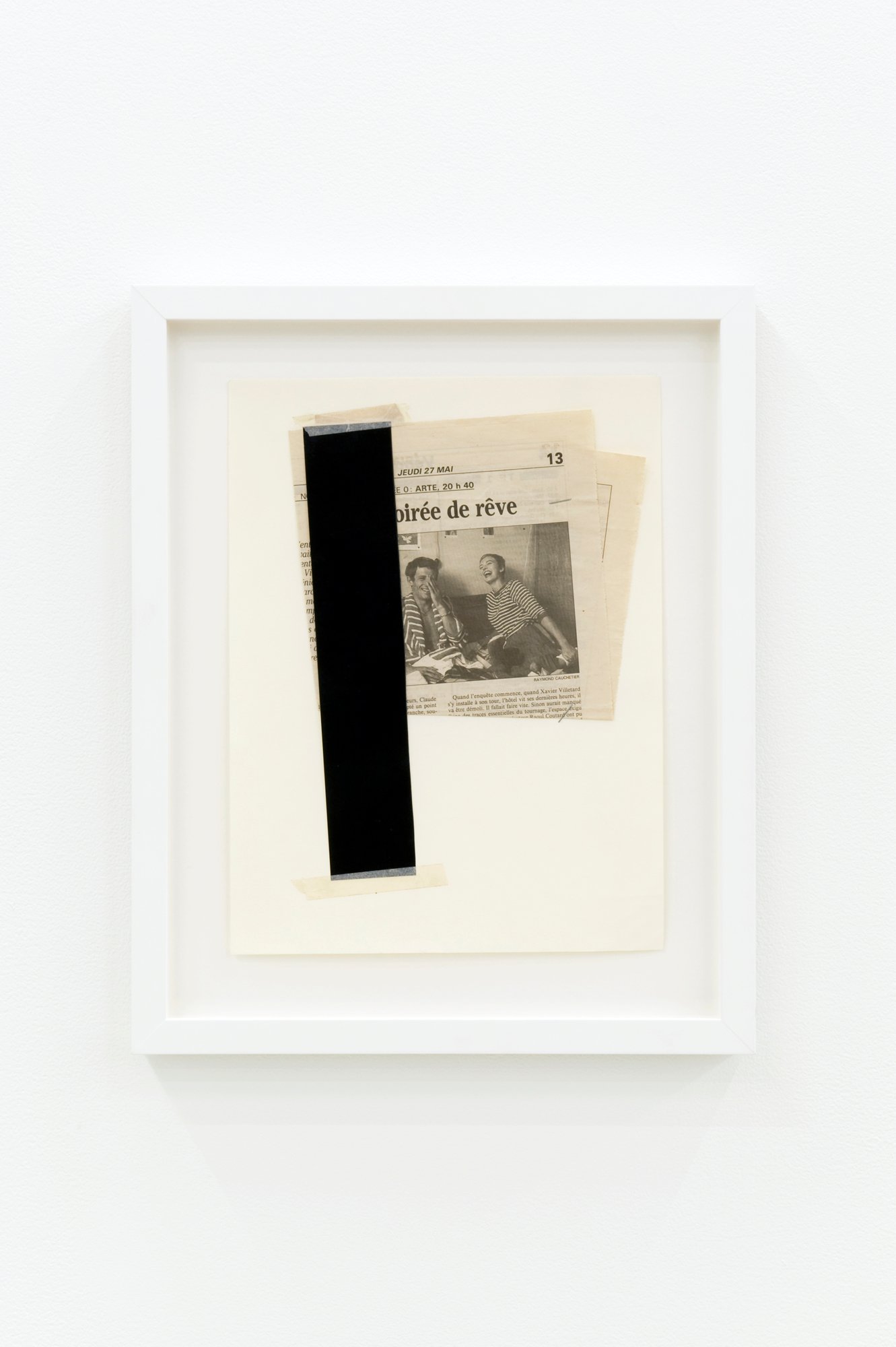
© » KADIST
Ian Wallace
Untitled (Breathless) presents a folded newspaper article on Jean-Luc Godard’s À Bout de Souffle (Breathless). The work uses collage techniques—it is stapled down and has a thick strip of contact sheet paper taped over it—that convert the media coverage on Godard’s film into a filmic object itself. The black paper enacts a kind of cinematic “jump cut” on the article, while simultaneously drawing attention to the medium of the film, as well as the photograph reproduced in this newspaper article.

© » KADIST
Kota Ezawa
The Simpson Verdict is a three-minute animation by Kota Ezawa that portrays the reading of the verdict during the OJ Simpson trial, known as the “most publicized” criminal trial in history. In 1995, OJ Simpson—a well-known American football player—was accused of the murders of his ex-wife Nicole Brown Simpson and her friend Ronald Goldman. Based on the courtroom footage, Ezawa uses his signature style to create an abstract and graphically simplified echo of what happened in the room.

© » KADIST
Michael Landy
H.2. N. Y Skeleton of the Dump revolves entirely around the performance “Homage to New York” (1960), of the Swiss artist Jean Tinguely (1925-1991), during which the machine built by the artist in the gardens of the Museum of Modern Art (MOMA) had to self-destruct itself in 27 minutes, but, in the end, it had to be finished off by firemenbeing called in after it erupted in flames. Since the discovery of Jean tinguely’s retrospective at the Tate Gallery in London, in 1982, Michael Landy spent two years researching and sketching (charcoal, oil, glue, ink) from his previous research carried out at Museum Tinguely in Basel, and at the MOMA in New York.

© » KADIST
Glenn Ligon
Drawing & Print (Drawing & Print)
Glenn Ligon’s diptych, Condition Repor t is comprised of two side-by-side prints. Though simple, each contains a nested stack of historical and self-referential quotations. Both black-and-white prints depict a version of Ligon’s 1988 painting, Untitled (I Am A Man) , which declares the words of the parenthetical in blocky black letters.

© » KADIST
Elad Lassry
In his composition, Chocolate Bars, Eggs, Milk, Lassry’s subjects are mirrored in their surroundings (both figuratively, through the chocolate colored backdrop and the brown frame; and literally, in the milky white, polished surface of the table), as the artist plays with color, shape, and the conventions of representational art both within and outside of the photographic tradition. Elad Lassry explores how visual languages are constructed across multiple disciplines and media. His larger body of work responds to the relationship between artistic mediums and their forms, and his prints question familiar modes of viewership and our continuous desire to find and identify clear narratives in photographs.

© » KADIST
Elad Lassry
In establishing a deliberate distance between viewer and subject, Lassry raises questions about representation itself and how all portraits are, in effect, fully constructed objects that only gain meaning once we ascribe them with our own personal associations and emotions. An example of this is Floor, Legs (2013), a gelatin silver print in which a large black rectangle obscures the upper half of a candid photograph with two figures that are ultimately only identifiable by their legs and feet, which are even then indiscernibly crossed and posed beyond easy recognition. Even though its unclear if Lassry’s source image is a found photograph or an original composition, the underlying themes – of the photograph’s function as an object, and the impossibility of discerning “the real” through its representation – continue to resonate.

© » KADIST
Karl Haendel
Drawing & Print (Drawing & Print)
Haendel’s series Knights (2011) is a set of impeccably drafted, nine-foot-tall pencil drawings depicting full suits of armor. The series riffs on previous investigations by the artist such as his meticulous depictions of masculine political figures, which included a headless J. Edgar Hoover and a Hitler head floating vulnerably in the center of a white expanse (Hitler’s iconic mustache was crafted from the artist’s pubic hair). Rendered in soft graphite, the imposing Knights embody the ostensibly conflicting ideals of chivalrous deference and invulnerable masculinity.
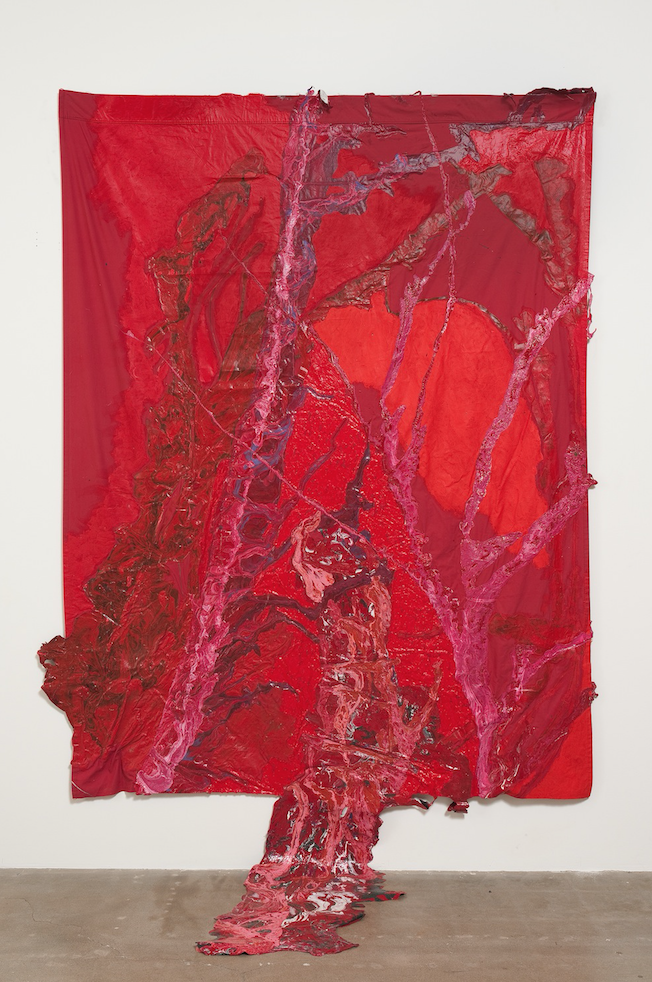
© » KADIST
Rodney McMillian
In his evocative Landscape Paintings, McMillian uses second-hand bedsheets, sourced from thrift shops, as his starting point. Calling up the unknown intimacies of these objects, McMillian upends their usual orientation, placing them directly on the wall to serve as paintings, rather than covers. Layering over the repurposed textiles with hardware store paint, McMillian transforms the sheets into canvases, creating abstract landscapes on top of the traces of human bodies intact in the fabric.

© » KADIST
John Baldessari
Arms & Legs (Specif. Elbows & Knees), etc. : Arm (with Bottle) belongs to Baldessari’s most recent series of paintings in which the artist brings together photographic, painted, and three-dimensional elements, to juxtapose unlikely body fragments such as noses and ears, elbows and knees, or eyebrows and foreheads.

© » KADIST
Douglas Gordon
Blind Spencer is part of the series “Blind Stars” including hundreds of works in which the artist cut out the eyes of Hollywood stars, in a symbolically violent manner. An emptiness (some are burned letting appear a white or mirror background or a mirror) replaces the eyes, giving the impression of a blind eye deprived of all expression. Paradoxically, the work looks at us all the more intensely.

© » KADIST
Bruce Conner
Unlike many of his earlier films which often present poignant critiques of mass media and its deleterious effects on American culture, EASTER MORNING , Conner’s final video work before his death in 2008, constitutes a far more meditative filmic essay in which a limited amount of images turn into compelling, almost hypnotic visual experience. The video presents us with a reinterpretation of footage from his unreleased avant-garde film, Easter Morning Raga , from 1966. In contrast to his more famous pieces like A Movie (1958) and Crossroads (1976) which are juxtapositions of fragments from newsreels, soft-core pornography, and B movies, the images in EASTER MORNING serve as a reinterpretation of footage.

© » KADIST
Douglas Gordon
In Monster (1996-97), the artist’s face becomes grotesque through the application of strips of transparent adhesive tape, typical of Gordon’s performance-based films that often depict his own body in action. Also characteristic of his work, the scene takes place in front of a mirror, suggesting the kind of personal self-reflection that one is capable of – both good and evil. The video makes clear cinematographic reference to the ‘alter-ego’ transformation in Mamoulian’s Dr. Jekyll and Mr. Hyde, and to the “You looking at me?” sequence performed in front of a mirror by Robert De Niro in Scorsese’s Taxi Driver which also inspired Gordon’s through a looking glass ( 1999).

© » KADIST
Hank Willis Thomas
Bread and Roses takes its name from a phrase famously used on picket signs and immortalized by the poet James Oppenheim in 1911. “Bread for all, and Roses, too’—a slogan of the women in the West,” is Oppenheim’s opening line, alluding to the workers’ goal for wages and conditions that would allow them to do more than simply survive. Thomas’ painting includes several black, white, brown, yellow, and red raised fists—clenched and high in the air in the internationally recognized symbol of solidarity, resistance, and unity.

© » KADIST
Hank Willis Thomas
Drawing & Print (Drawing & Print)
Thomas’ lenticular text-based works require viewers to shift positions as they view them in order to fully absorb their content. Meaning, therefore, changes depending on one’s perspective—and in the case of Thomas’ installation, only emerges when one knows that there is always something hidden, always more to one of his works than immediately meets the eye. This lenticular print with text shifts as you walk in front of it from its title, “Black Imitates White” to the inverse, “White Imitates Black”(and some other possibilities in between) emphasizing that there are always at least two perspectives to the same scenario, and thereby encouraging us as viewers to consider them all together rather than trying to identify with any one subjectivity.
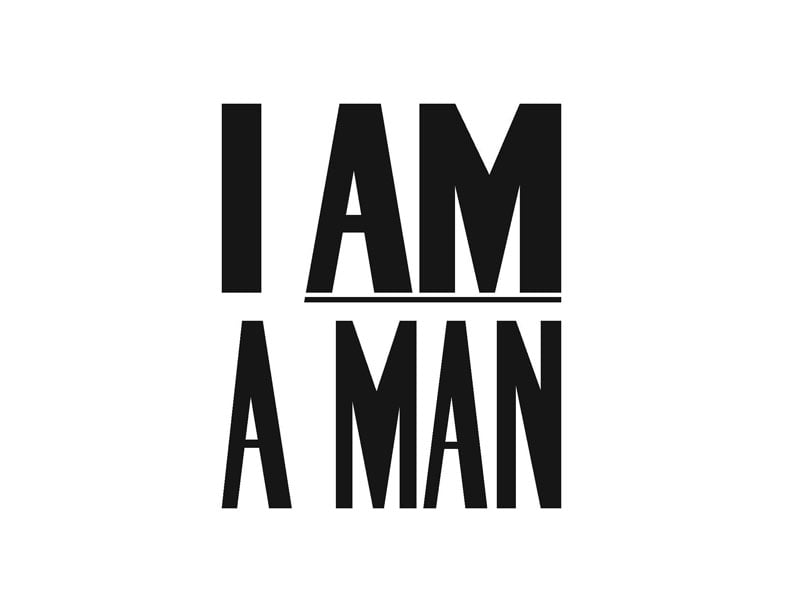
© » KADIST
Hank Willis Thomas
The image is borrowed from protests during Civil Rights where African Americans in the south would carry signs with the same message to assert their rights against segregation and racism. Historically, in countries such as the US and South Africa, the term “boy” was used as a pejorative and racist insult towards men of color, slaves in particular, signifying their alleged subservient status as being less than men. In response, Am I Not A Man And A Brother?

© » KADIST
Hank Willis Thomas
Like many of his other sculptural works, the source of I am the Greatest is actually a historical photograph of an identical button pin from the 1960s. I am the Greatest presents the famous quote by Mohammad Ali to think about his important presence in the African American community. In dialogue with the painting I am a Man, also in the Kadist collection, this assertion that begins the same way takes the line from the protest poster several steps further.

© » KADIST
Hank Willis Thomas
Drawing & Print (Drawing & Print)
Shot in black and white and printed on a glittery carborundum surface, Black Hands, White Cotton both confronts and abstracts the subject of its title. As with many of his works, the artist has taken a found image and manipulated it to draw out and dramatize the formal contrast between the black hands holding white cotton. Cotton, of course is one of the most familiar fabric sources to us, and becomes incredibly soft once processed.
Hank Willis Thomas
- location: New York, New York
- year born: 1976
- gender: male
- nationality: American
- home town: Plainfield, New Jersey
Mungo Thomson
- location: Los Angeles, California
- year born: 1969
- gender: male
- nationality: American
Jonathan Monk
- location: Berlin, Germany
- year born: 1969
- gender: male
- nationality: British
- home town: Leicester, United Kingdom
Kota Ezawa
- location: San Francisco, California
- year born: 1969
- gender: male
- nationality: German
- home town: Cologne, Germany
Douglas Gordon
- location: Berlin, Germany
- year born: 1966
- gender: male
- nationality: Scottish
- home town: Glasgow, United Kingdom
Will Rogan
- location: Albany, California
- year born: 1975
- gender: male
- nationality: American
Ian Wallace
- year born: 1943
- gender: male
- nationality: British
- home town: Shoreham, United Kingdom
Juan Capistran
- location: Los Angeles, California
- gender: male
- nationality: Mexican American
- home town: Guadalajara, Mexico
John Baldessari
- location: Los Angeles, California
- year born: 1931
- gender: male
- nationality: American
- home town: National City, California
Daniel Joseph Martinez
- location: Los Angeles, California
- year born: 1957
- gender: male
- nationality: American
- home town: Los Angeles, California
Lisa Oppenheim
- location: New York, New York
- year born: 1975
- gender: female
- nationality: American
- home town: New York, New York
Bruce Conner
- location: San Francisco, California
- year born: 1933
- gender: male
- nationality: American
- home town: McPherson, Kansas
Wallace Berman
- location: California
- year born: 1926
- gender: male
- nationality: American
- home town: Staten Island, New York
Matt Lipps
- location: San Francisco, California
- year born: 1975
- gender: male
- nationality: American
- home town: San Francisco, California
Li Ran
- location: Beijing, China
- year born: 1986
- gender: male
- nationality: Chinese
- home town: Hubei Province, China
Alexis Smith
- location: Los Angeles, California
- year born: 1949
- gender: female
- nationality: American
- home town: Los Angeles, California
Edward Kienholz
- location: Los Angeles, California
- year born: 1927
- gender: male
- nationality: American
- home town: Fairfield, Washington
Ozawa Tsuyoshi
Ozawa Tsuyoshi is a Japanese conceptual artist who constructs satirical takes on history...
Rodney McMillian
- location: Los Angeles, California
- year born: 1969
- gender: male
- nationality: American
- home town: Columbia, South Carolina
Oliver Laric
- location: Berlin, Germany
- year born: 1981
- gender: male
- nationality: Austrian
- home town: Innsbruck, Austria
Glenn Ligon
- location: New York, New York
- year born: 1960
- gender: male
- nationality: American
- home town: Bronx, New York
Jin Shan
Jin Shan is an installation artist who uses humor, satire, and play to comment upon social and political power dynamics within contemporary China...
Karl Haendel
- location: Los Angeles, California
- year born: 1976
- gender: male
- nationality: American
- home town: New York, New York
Wang Taocheng
Wang Taocheng is a Shanghai artist who lives and works in Amsterdam...
Zhang Peili
- location: Hangzhou, China
- year born: 1957
- gender: male
- nationality: Chinese
- home town: Hangzhou, China
Brian Jungen
- location: Vancouver, British Columbia
- year born: 1970
- gender: male
- nationality: Canadian
- home town: Ft. Saint John, Canada
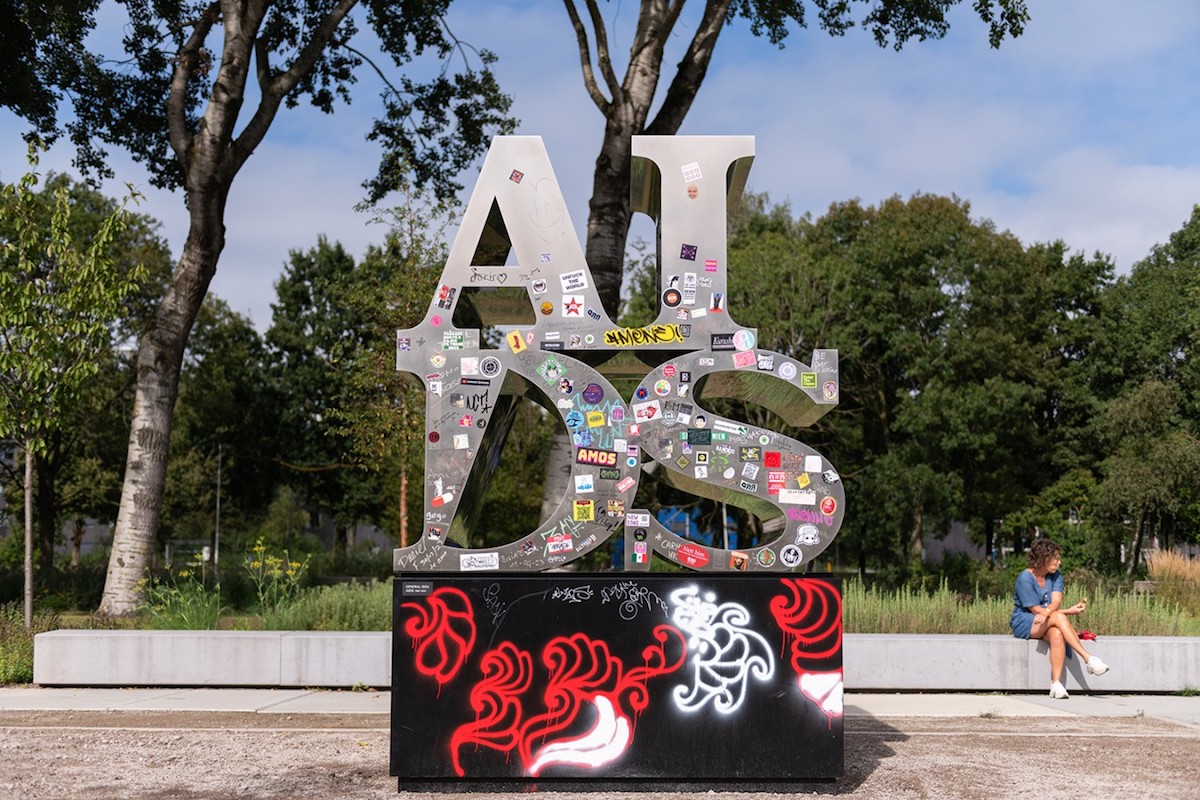
© » ARTLYST
about 6 months ago (10/09/2023)
Following its display at the General Idea retrospective in Stedelijk Museum Amsterdam The post AIDS Sculpture By General Idea Finds Permanent Home In Amsterdam Park appeared first on Artlyst ....
-
1960-1969
Wallace Berman
1969While Untitled (Shuffle) presents the same formal characteristics as the rest of Berman’s verifax collages, this constellation of specific images inside the radio’s frames—the Star of David, Hebrew characters, biblical animals—have Jewish symbolism and attest to the artist’s lasting obsession with the kabala...
-
1970-1979
Daniel Joseph Martinez
1978For I use to eat lemon meringue pie till I overloaded on my pancreas with sugar and passed out; It seemed to be a natural response to a society of abundance (1978), also known as the Bodybuilder series, Martinez asked male bodybuilding competitors to pose in whatever position felt “most natural.” They are obviously trained in presenting their ambitiously carved physiques, but their facial expressions seem comparatively unstudied...
Bruce Conner
1978In 1977, as an already-established artist best known for his films, Bruce Conner began to photograph punk rock shows at Mabuhay Gardens, a San Francisco club and music venue...
-
1980-1989
Charles Gaines
1980To make his series Shadows (1980), Gaines subjected 20 potted plants to a uniform procedure...
Edward Kienholz
1984Untitled (San Francisco) was made in Idaho in 1984 and was facetiously dedicated to Henry Hopkins, the then director of the San Francisco Museum of Art who added “modern” to its name...
Ian Wallace
1986Wallace says of his Heroes in the Street series, “The street is the site, metaphorically as well as in actuality, of all the forces of society and economics imploded upon the individual, who, moving within the dense forest of symbols of the modern city, can achieve the status of the heroic.” The hero in Study for my Heroes in the Street (Stan) is the photoconceptual artist Stan Douglas, who is depicted here (and also included in the Kadist Collection) as an archetypal figure restlessly drifting the streets of the modern world...
-
1990-1999
Alexis Smith
1990Iron Sorrows (1990) brings together what are for Alexis Smith common motifs and materials such as scavenged and repurposed metal, and street signage...
John Baldessari
Drawing & Print
1991(Drawing & Print) The voids in Baldessari’s painted photographs are simultaneously positive and negative spaces, both additive and subtractive...
General Idea
1993AIDS Ring by General Idea is a cast metal ring, which takes as its basis Robert Indiana’s iconic “LOVE” design, appropriating its pop aesthetic, and totalizing, simplistic universal messaging to instead emphasize the severity of the AIDS epidemic that occurred in the 1970s...
Alexis Smith
1995In 8 Ball Surfboard (1995),Alexis Smith combines her long-term interests in California culture and conceptual assemblage...
Bruce Conner
Drawing & Print
1995(Drawing & Print) Bruce Conner is best known for his experimental films, but throughout his career he also worked with pen, ink, and paper to create drawings ranging from psychedelic patterns to repetitious inkblot compositions...
Douglas Gordon
1996In Monster (1996-97), the artist’s face becomes grotesque through the application of strips of transparent adhesive tape, typical of Gordon’s performance-based films that often depict his own body in action...
Mike Kelley
1996Towhead n’Ganga, enclosed in darkness, lorded over by the sexualized folded high priestless form reflects many of Kelley’s works, in both its compositional and semantic qualities...
John Baldessari
1997In One Must , an image of a pair of scissors, accompanied by the words of work’s title, poses an ominous question about the relationship between the image and the text...
-
2000-2009
Glenn Ligon
Drawing & Print
2000(Drawing & Print) Glenn Ligon’s diptych, Condition Repor t is comprised of two side-by-side prints...
Ian Wallace
2000Untitled (Breathless) presents a folded newspaper article on Jean-Luc Godard’s À Bout de Souffle (Breathless)...
Juan Capistran
2002The Breaks reflects Capistran’s interests in sampling and fusing different cultural, social, and historical sources...
Kota Ezawa
2002The Simpson Verdict is a three-minute animation by Kota Ezawa that portrays the reading of the verdict during the OJ Simpson trial, known as the “most publicized” criminal trial in history...
Douglas Gordon
2002Blind Spencer is part of the series “Blind Stars” including hundreds of works in which the artist cut out the eyes of Hollywood stars, in a symbolically violent manner...
Lisa Oppenheim
Drawing & Print
2003(Drawing & Print) The Damaged series by Lisa Oppenheim takes a series of selected photographs from the Chicago Daily News (1902 – 1933) as its source material...
Jonathan Monk
2003Untitled (rolled up) , is an abstract portrait of Owen Monk, the artist’s father and features an aluminum ring of 56.6 cm in diameter measuring 1.77 cm in circumference, the size of his father...
Lisa Oppenheim
Drawing & Print
2003(Drawing & Print) The Damaged series by Lisa Oppenheim takes a series of selected photographs from the Chicago Daily News (1902 – 1933) as its source material...
Lisa Oppenheim
Drawing & Print
2003(Drawing & Print) The Damaged series by Lisa Oppenheim takes a series of selected photographs from the Chicago Daily News (1902 – 1933) as its source material...
Kelley Walker
2004The triptych Black Star Press is part of the series ‘The Black Star Press project’ initiated in 2004 by the American artist Kelley Walker...
Douglas Gordon
2004Douglas Gordon’s single-channel video The Left Hand Can’t See That The Right Hand is Blind, captures an unfolding scene between two hands in leather gloves—at first seemingly comfortable to be entwined, and later, engaged in a struggle...
Mark Leckey
2004In Made In Heaven , we are face to face with a sculptural apparition, a divine visitation in the artist’s studio...
Daniel Joseph Martinez
2005Martinez’s sculpture A meditation on the possibility… of romantic love or where you goin’ with that gun in your hand , Bobby Seale and Huey Newton discuss the relationship between expressionism and social reality in Hitler’s painting depicts the legendary Black Panther leaders Huey P...
Juan Capistran
2005White Minority , is typical of Capistran’s sampling of high art genres and living subcultures in which the artist subsumes an object’s high art pedigree within a vernacular art form...
Will Rogan
2007Shot in the streets of Tokyo, Collapse , is a meditation on the passing of time and on the complicated way in which we are smashed between the past and the future...
Aaron Young
2007The artist describes the work as “very performative video-pieces but they take on a more sculptural feel...
Rivane Neuenschwander
2007Mapa-Mundi BR (postal) is a set of wooden shelves holding postcards that depict locations in Brazil named for foreign countries and cities...
Luke Butler
Drawing & Print
2008(Drawing & Print) In Captain X , Star Trek’s Captain Kirk, played by William Shatner, is limply draped over a large boulder in what looks like a hostile alien environment...
Jonathan Hernández
2008In line with Hernández’s interest in catastrophe, Vulnerabilia (choques) is a collection of images of shipwrecks and Vulnerabilia (naufragios) collects scenes of car crashes...
Bruce Conner
2008Unlike many of his earlier films which often present poignant critiques of mass media and its deleterious effects on American culture, EASTER MORNING , Conner’s final video work before his death in 2008, constitutes a far more meditative filmic essay in which a limited amount of images turn into compelling, almost hypnotic visual experience...
Alessandro Balteo Yazbeck
2008Part of a larger series of photographic works, Alessandro Balteo Yazbeck’s Corrupted file from page 14 (V1) from the series La Vega, Plan Caracas No...
Mungo Thomson
Drawing & Print
2008(Drawing & Print) The White Album (2008) presents a compilation of one hundred issues of Artforum magazine released between 1970 and 1979...
Zhang Peili
2008In the video installation A Gust of Wind , Zhang continues to explore notions of perspective and melds them seamlessly with a veiled but incisive social critique...
Nicolás Consuegra
2008In his project Instituto de Vision (2008), Consuegra investigates how modernism gave rise to many new technological forms of vision, most notably the camera, yet also resulted in the disappearance of outmoded forms of vision...
Dinh Q. Lê
2008Hill of Poisonous Trees (three men) (2008) exemplifies the artist’s signature photo-weaving technique, in which he collects diverse found photographs—portraits of anonymous people, stills from blockbuster films, or journalistic images—cuts them into strips, and weaves them into new composition...
-
2010-2019
Hamra Abbas
2010At first glance, Cityscapes (2010) seems to be a collection of panoramic photographs of the city of Istanbul—the kind that are found on postcards in souvenir shops...
Mungo Thomson
2010In Thomson’s Untitled (TIME) , every front cover of TIME magazine is sequentially projected to scale at thirty frames per second...
Will Rogan
Drawing & Print
2010(Drawing & Print) MUM , the acronym used to title a series of Rogan’s small interventions on found magazines, stands for “Magic Unity Might,” the name of a vintage trade magic publication...
Matt Lipps
2011Untitled (Women) (2011) presents a startlingly succinct history of violently romanticized femininity...
Karl Haendel
Drawing & Print
2011(Drawing & Print) Haendel’s series Knights (2011) is a set of impeccably drafted, nine-foot-tall pencil drawings depicting full suits of armor...
Matt Lipps
2011In the series Horizons (2010), Lipps uses appropriation to riff on Modernism’s fascination with abstract form...
Hank Willis Thomas
2012Bread and Roses takes its name from a phrase famously used on picket signs and immortalized by the poet James Oppenheim in 1911...
Hank Willis Thomas
Drawing & Print
2012(Drawing & Print) Thomas’ lenticular text-based works require viewers to shift positions as they view them in order to fully absorb their content...
Hank Willis Thomas
2012Like many of his other sculptural works, the source of I am the Greatest is actually a historical photograph of an identical button pin from the 1960s...
Elad Lassry
2012The black-and-white photograph Men (055, 065) (2012) depicts two similarly built young men – young and slim, with dark tousled hair and a square jaw line – seated aside one another in identical outfits...
Nicolás Paris
2012Nicolas Paris studied architecture and worked as an elementary school teacher before he decided to become an artist...
Juan Capistran
2012The 10 $1 bills that make up From a Whisper to a Scream (2012) read like instructions in origami...
Hank Willis Thomas
Drawing & Print
2012(Drawing & Print) Intentionally Left Blanc alludes to the technical process of its own (non)production; a procedure known as retro-reflective screen printing in which the image is only fully brought to life through its exposure to flash lighting...
Nicolás Consuegra
2012A residency program in the blazing hot city of Honda, Colombia, inspired artist Nicolás Consuegra to consider the difficulty in understanding the needs of a distant community...
Oliver Laric
2012Oliver Laric’s video Versions is part of an ongoing body of work that has continued to evolve and mutate over time...
Hank Willis Thomas
2013The image is borrowed from protests during Civil Rights where African Americans in the south would carry signs with the same message to assert their rights against segregation and racism...
Elad Lassry
2013In his composition, Chocolate Bars, Eggs, Milk, Lassry’s subjects are mirrored in their surroundings (both figuratively, through the chocolate colored backdrop and the brown frame; and literally, in the milky white, polished surface of the table), as the artist plays with color, shape, and the conventions of representational art both within and outside of the photographic tradition...
Elad Lassry
2013In establishing a deliberate distance between viewer and subject, Lassry raises questions about representation itself and how all portraits are, in effect, fully constructed objects that only gain meaning once we ascribe them with our own personal associations and emotions...
Rodney McMillian
2013In his evocative Landscape Paintings, McMillian uses second-hand bedsheets, sourced from thrift shops, as his starting point...
Brian Bress
2013Blindseye Arranger (Max) (2013) features a greyscale arrangement of rudimentary shapes layered atop one another like a dense cluster of wood block prints, the juxtaposition of sharp lines and acute angles creating an abstracted field of rectangular and triangulated forms composed as if in a cubist landscape...
Hank Willis Thomas
Drawing & Print
2014(Drawing & Print) Shot in black and white and printed on a glittery carborundum surface, Black Hands, White Cotton both confronts and abstracts the subject of its title...
Will Rogan
2014Will Rogan’s video Eraser (2014) shows a hearse parked in a clearing amidst leaf barren trees...
Mungo Thomson
2014Starting with Bruce Nauman’s iconic artwork, The True Artist Helps the World by Revealing Mystic Truths (Window or Wall Sign) , Mungo Thomson’s neon sign is one of a series that replaces Nauman’s quixotic mini-manifesto with aphorisms from ‘recovery’ culture, especially those made popular by alcoholics anonymous...
Kota Ezawa
2014Paint and Unpaint is an animation by Kota Ezawa based on a scene from a popular 1951 film by Hans Namuth featuring Jackson Pollock...
Hank Willis Thomas
2014South Africa Righteous Space by Hank Willis Thomas is concerned with history and identity, with the way race and ‘blackness’ has not only been informed but deliberately shaped and constructed by various forces – first through colonialism and slavery, and more recently through mass media and advertising – and reminds us of the financial and economic stakes that have always been involved in representations of race....
Nicolás Consuegra
2014Consuegra’s Colombia is a mirror made in the shape of the artist’s home country—a silhouette that has an important resonance for the artist...
Kota Ezawa
2017The Crime of Art is an animation by Kota Ezawa that appropriates scenes from various popular Hollywood films featuring the theft of artworks: a Monet painting in The Thomas Crown Affair (1999), a Rembrandt in Entrapment (1999), a Cellini in How to Steal a Million (1966), and an emerald encrusted dagger in Topkapi (1964)...










